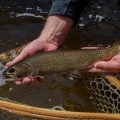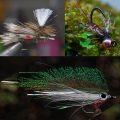How to Tie a Dark Hendrickson Wet Fly
Producer: Tim Flagler
Ever since I started tying flies, a Dark Hendrickson Wet has been one of my favorites. It’s simple, elegant, fun to tie and it works pretty much regardless of how it’s fished. What’s not to like?
A Mustad 3906B used to be my go-to hook for this pattern but, here, I’m going to update it a bit and use a Fulling Mill 51 05 in size 14. Begin by getting the hook firmly secured in the jaws of your tying vise.
For thread, I’ve loaded a bobbin with a spool of Veevus 16/0 in brown. Get the thread started on the hook shank a little ways behind the eye and, after snipping off the excess tag, continue taking wraps rearward, until your thread hangs at about the hook point.
Medium dun hen hackle is used for both the tail and the collar of the fly. For the tail, locate one of the larger feathers with some nice, stiff, straight fibers. Pull down and strip off the fibers from the lower, thicker part of the stem. Then, preen down a dozen or so attractive-looking fibers, perpendicular to the stem and pull the stem away to strip them free. This should keep the butts and the tips of the fibers aligned. Measure to form a tail a hook shank in length and transfer that measurement rearward to the start of the hook bend. Take thread wraps rearward to anchor the fibers to the top of the hook shank, all the way back to the start of the bend. Then take thread wraps forward to pin down the butt ends of the fibers. Once again, end with your tying thread at about the hook point.
Natural muskrat fur is used to form the body of the fly. Pull a fairly ample pinch or two free from the packet. Use the fur to create a slender, slightly tapered 2” long noodle on your tying thread. Start taking wraps with the noodle so the dubbing begins right at the base of the tail. Continue taking forward wraps to create a gently tapered body on the fly. I shorted myself on the dubbing a bit so I’m going to go back to the packet, and this time, retrieve a much smaller clump of muskrat fur. I’ll use this to produce a short, very slender noodle on my tying thread. Then, it’s just a matter of taking wraps with that noodle to continue making the abdomen of the fly, which should ideally end about an eye-length back from the back edge of the hook eye.
Using the same hen hackle as you did for the tail, this time, measure to find a feather with barbules the correct length for the hook size, here, 14. Once you’re certain the feather’s of the correct size, pluck it free from the skin. To prep the feather for tie-in, get the shiny or front side facing you, and gently pull down the lower fibers to expose the feather’s tip. Snip the majority of the tip off, leaving a small triangular-shaped tie-in anchor. Lay the anchor against the near side of the hook and take thread wraps to secure it. Make sure it’s locked down really well. End with your tying thread just back from the hook eye.
Reach for your favorite hackle pliers and get hold of the feather’s butt end. Preen the fibers rearward as you bend the stem down through your fingertips. This should lightly fold the fibers rearward. Start taking wraps with the feather, preening the fibers back as you go. After 2 or 3 turns, use your tying thread to anchor the feather’s stem to the hook shank, then snip the excess off close. Once again preen the fibers rearward and take a few more thread wraps to clean up the head area, then leave your thread immediately in front of the collar.
Barred lemon wood duck is used for the wing of the fly. Strip away the lower, shorter fibers from both sides of the stem, so the tips, on what remains, are fairly even. Isolate the feather’s tip, so it includes about a dozen fibers on each side of the stem, then snip it free. With the stem end in the fingertips of your right hand, measure to form a wing that extends just past the bend of the hook. Lay the fibers against the near side of the hook and take a wrap of tying thread to kind of fold them over the hook shank. Make sure the wing is of the correct length and orientation, then lock it down with a few more thread wraps. It should look something like this.
Now’s a good time to locate what’s left of that valuable wood duck feather. It can be used to make one or maybe even two more Dark Hendrickson Wet flies. So, stash it away in a safe place, like between the sheets of a sticky pad.
Lift the butt ends of the wood duck fibers up and, using the hook eye as a guide for your scissors, snip them off close. Take just enough wraps of tying thread to cover the butt ends but resist the urge to take excessive wraps. Once again, make sure the wing is correctly oriented . Reach for your whip finish tool and use it to do a 5 or 6 turn whip finish, seat the knot well and snip or cut your tying thread free. A drop of head cement, here Sally Hansen Hard as Nails, applied to the thread wraps and allowed to sink in and dry, ensures nothing will unravel or pull free.
And that’s a Dark Hendrickson Wet fly. It’s a toss-up which is more fun for me, tying this pattern or fishing it.
How to Tie a Darbee Stonefly Nymph (Classic Catskill Nymph)
How to Tie a Deadly Popper Fry Fly











